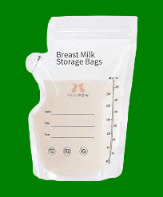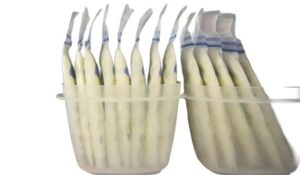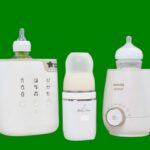How to Thaw Frozen Breast Milk Safely is a crucial skill for new parents, especially at urgent times. Thawing frozen Breast Milk is especially painful for new parents. This is particularly true during the urgent time of using frozen breast milk, a saved stash that the mother pumped. Therefore, it is, crucial to understand “how to thaw frozen milk safely.“ By following the right way, it can be thawed while ensuring maximum safety for both the infant and the milk. The right way to thaw frozen milk will make feeding your little one easier.
This is true whether you are on a coffee run or it’s midnight. All you need to do is learn the right techniques and methods of thawing.
Moreover, this guide will share best practices for thawing frozen breast milk. On the other hand, it will ensure your baby gets the highest quality, most nutritious milk for their growth. In short, everything you need to know about thawing breast milk.

Breast milk has essential nutrients. They help your baby grow and develop. If you have been pumping and freezing, you must know how to thaw it without losing hope.
Here is all that you should know about the frozen breast milk thawing technique. As a new parent, it is your responsibility to ensure that the baby is getting the right amount of nutrients. If you freeze the milk, knowing how to thaw it is significant as it keeps the nutrition intact. Here is how to freeze breast milk the right way:
How to Safely Freeze Breast Milk:
A Step-by-Step guide Freezing breast milk will ensure your baby gets enough nutrition. This is vital when you’re out and about or in an emergency. Proper storage will keep the milk’s quality, nutrition, and safety. The following is how to go about setting up a frozen breast milk stash:
- Prepare for Pumping
- We recommend that you wash your hands and keep them clean to avoid any form of contamination.
- Clean Equipment: Use a sterile breast pump and containers to pump and store milk.
- Pump breast milk
- Follow the manufacturer’s instructions for your breast pump.
- Pump into a clean, sterilized container to maintain hygiene.
- Store the milk.
- Choose appropriate containers.
- Use BPA-free breast milk storage bags. Or use sterilized glass or plastic containers with tight-fitting lids.
- Label the Storage: The container should have the date and time of pumping. The first should use the oldest milk.
- Portion the milk: Freeze in small containers (2-4 ounces) to reduce waste when thawing.
- Freeze the milk.
- Place the storage bags or containers upright in the freezer.
- Leave some space at the top of the containers because breast milk expands when it is frozen.
- Store cheese in the back of the fridge. It is the coldest there.
- Follow storage guidelines.
- Breast milk can be stored:
- At room temperature (77°F or below) for no more than four hours.
- In the refrigerator for up to four days.
- Freeze for up to 6 months (perfect) or 12 months as the maximum limit.
These steps will help you create a frozen breast milk supply. It will provide nutritious milk for your baby whenever it’s needed.
Effect Waya to Thawing Frozen Milk and Why It Important
Milk is a very delicate compound and needs to be taken care of at all times. It can turn rancid without goodness very easily if not handled properly. Freezing breast milk is a great way to stock frozen treats for your child. But it will kill some nutrients. Knowing which techniques are best is the only way to ensure that your child reaps the full rewards.
- Use the refrigerator for slow thawing. The best way to defrost frozen breast milk is to place it in the fridge. This procedure may take a few hours, or a full night or more. It maintains the safety of the milk while also keeping its helpful components. This method helps retain taste and stops harmful germs from growing. The duration of breastfeeding at such a temperature would not exceed 24 hours.

Find insulated milk storage bags. They should keep breast milk at the right temperature while on vacation or moving around. To preserve your breast milk until it thaws, use this highly rated cooler for the storage bags.
- Thaw under warm, running water.
Use warm or slightly hot water. If in a hurry, put the frozen milk container under a warm water tap. Don’t let any parts of the warmed breast milk touch scorching hot water. It could ruin the texture.
- Use a breast milk warmer.
A trusty breast milk warmer makes warming milk for your baby easy. It heats the milk evenly and prevents it from getting too hot.

If you work with lactating women, breast milk warming machines may help with thawing issues. This device warms the milk without hot spots. It helps retain the milk’s nutrition.
A breast milk heater can be particularly beneficial for working parents. These machines unfreeze and heat the milk to safe levels. They prevent overheating the milk. Many breast milk warmers have controls to heat the milk evenly. This greatly simplifies the task and saves time.
Find a top-selling, aspirational bottle warmer. Some mothers say it always heats breast milk to the perfect temperature. It’s a great product for people who are always on the move and would like to heat the milk whenever necessary.
- Never microwave frozen milk.
Heating breast warmers is usually discouraged. It may cause food poisoning from hot spots. These may burn the child and, most significantly, cause burns. Soaking or warming a bottle is the recommended method.
- How to Store Thawed Milk
Unfortunately, you should never refreeze thawed breast milk. It adds health risks. Once thawed, use it within 24 hours or put it in the refrigerator. Refrigerate the nipple bottle’s contents for two hours. Then, breastfeed or watch a TV show. This makes it safer.
Know the details about the Thawing Frozen Breast milk process
If a new mother pumps fresh milk, she should use it within four days. After that, it may spoil. Frozen breast milk has a longer shelf life as it stays good for up to six months. Always use containers that will allow you to track the date, as it is important.
If the mother will store the milk for long periods, use high-quality breast milk storage bags. They will help protect the milk from infection. Many of the bags are designed with what is known as a double zipper, which can help prevent leaks and spoilage.
A key piece of advice for breastfeeding or pumping moms is to record the date of each pumping and freezing. To track your frozen breast milk’s storage life, use labels and suitable bags. They will help keep the milk’s quality.

Use a milk storage organizer or a label maker to organize your breast milk. This simple little gadget will save you oodles of time and confusion!
Bonus Tips on the Storage and Thawing of Milk:
- Avoid Thawing and Refreezing: Do not refreeze thawed milk. It’s better to thaw only the amount you will use.
- Check the milk before feeding. The palm is the mouth for this duty. The baby must use or adjust it as per the following authorities.
- Use Milk Within 2 Hours: Once milk is thawed, it should not stay at room temperature for more than 2 hours. It should be kept within a safe temperature range to avoid bacterial growth.
These simple, safe methods will keep the temperature in check. They will be stored well after reshaping, so there are no worries.
Drawbacks
We must first appreciate that there are two sides to this. On one hand, freezing and thawing breast milk is very convenient. On the other, it might hurt the mother’s breastfeeding experience. There are at least three reasons to be careful when thawing frozen breast milk. Some solutions may help with those issues:
- Loss of Nutrients
In simple terms, extremes risk the nutrients in babies. These include enzymes and antibodies that boost their immune systems. Hot water or a microwave ruin the nutrients in thawed breast milk.
In other words, buy an advanced breast milk warmer. It should gently warm the milk to the best temperature without overheating it. Also, choose a breast milk warmer with optimal temperature settings. This will help preserve the milk’s nutrients.
- Shelf-Life Limit Once Thawed
Once frozen breast milk is in a liquid state, it can only last for a limited period. If you do not use the thawed, refrigerated milk, consume it within 24 hours. If the thawed milk is kept at room temperature, it is unsafe after 2 hours. Be very careful with the amount of milk you thaw. A small part will be enough, but the rest will go to waste if you aren’t careful.
Use breast milk storage bags. Label them with the time and date they were pumped. This will minimize wastage. Also, buy smaller containers to freeze less iced milk. This will prevent excess milk from thawing.
- Thawing breast. Milk is a time-consuming process.
Breast milk freezes well. But it takes a long time to thaw. This is especially true if you use the defrost setting or a fridge. It can take hours or overnight. This can be irritating if you’re in a hurry and need breast milk. A midnight meeting with a hungry baby is no fantasy.

Use a fast breast milk warmer to improve and speed up thawing. If you lack a breast warmer, you can use insulated cooler bags to maintain the milk. Some breast milk warmers heat the milk quickly, achieving the perfect temperature. Such options guarantee that thawing the milk can be quick whenever necessary.
Knowing these cons and having the right devices can help. They can reduce nutrient loss, waste, and thawing time. Buying the right products simplifies the thawing process. So, we can always feed the child premium nutrition. Our partners’ breast milk storage and warmer products can help. They make feeding your baby easier and more enjoyable.
FAQs
- What is the best method to unfreeze breast milk without causing any harm?
The slow method of placing frozen breast milk into the fridge helps to thaw it. It preserves the nutrients and keeps it at a safe temperature.
- Can I thaw breast milk in the microwave?
No, many people warm breast milk in the microwave regularly. Microwaving breast milk can create hot spots. It can get too hot or too cold at the same time. Such extremes can be dangerous. They can destroy vital elements. They can also cause serious burns to your baby’s mouth. Additionally, better options are available, such as a breast milk warmer or warm water to thaw breast milk.
- Can I thaw breast milk with hot water?
Yes! You can use warm water to thaw breast milk. However, do not use hot water to warm it. You can take a bowl, fill it with warm water, and place the breast milk in it for quicker results. This way, the water can be at breast temperature, which lies near 37 degrees Celsius.
- How long can you keep thawed breast milk in the fridge?
The best practice is to expel frozen breast milk if you have stored it in the fridge for over 24 hours. Do not refreeze breast milk. It lowers the freezing point each time. This can cause malfunctions. Also, throw out milk that has been at room temperature for over two hours.
- Can I thaw frozen breast milk in water?
It is best not to keep frozen or wet breast milk at room temperature. Both summer and winter room temperatures are unsafe for thawing in the fridge. However, a few hours are fine. It allows time to soak and half-thaw breast milk. It’s better to use warm water or a refrigerator.
- Can I thaw breast milk and then refreeze it?
No, after thawing, do not refreeze the breast milk. It would ruin its quality. You must consume thawed breast milk within 24 hours. It must not be at room temperature for more than two hours.
- Can I use a breast milk warmer to thaw breast milk?
Not possible to remove the adverb. A breast milk warmer is one of the easiest and most effective tools for warming milk. Such devices heat milk to a uniform temperature without causing it to burn. They don’t exceed the right temperature.
- My baby drank from a bottle, and then I warmed up more milk. What can I do?
However, if your baby does not finish a bottle, you should consume the remaining milk within two hours. If someone has consumed the milk or left it out of the fridge for a long time, you must not reapply it. Never freeze or put back in the fridge the milk once it has been drunk.
- How should I go about moreover preventing breast milk from freezing in the first place?
You should store your breast milk in a BPA-free container or storage bag. This will prevent it from drying and getting distorted. Also, make sure to seal, suffocating all the air. As a reminder, you should label the liquid with the date and time you expressed it. Therefore, this will prevent confusion when retrieving it.
- How do I warm frozen, stored breast milk without losing its nutrients?
A stored bottle can warm the liquid. Moreover, it works better than placing the frozen container in warm water. One key reason to use low heat is that it’s safer. On the other hand, high temperatures can burn and ruin valuable minerals in the milk.
These simple answers can help you find the best way to thaw frozen breast milk. They will ensure your child gets all the nutrients. The qualities of the milk will not disappear.
Conclusion: Thawing Frozen Breast Milk with Confidence
Thawing frozen breast milk is not hard; However, keep it below a certain temperature. For instance, you can do it through a stored warmer or by placing it in the fridge for a period. Interestingly, chefs mold butter and cheese using low-heat techniques.
When it comes to, the best ways to store and thaw breast milk. In fact, we have the tools you need for enjoyable feeding times. For example, you can use our insulated bag or breast milk warmer!
